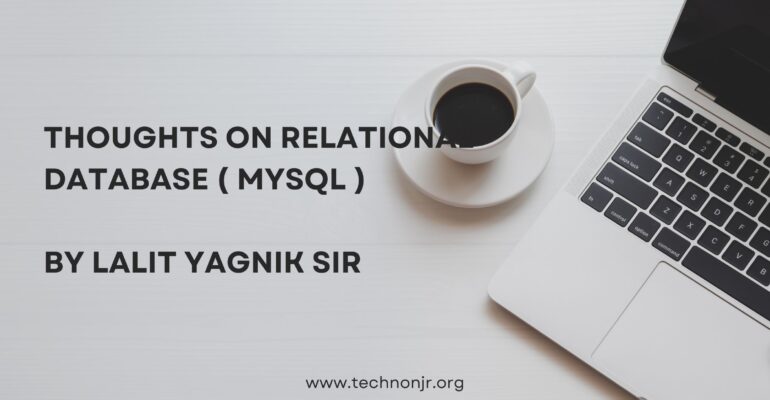Thoughts on relational database ( MySQL ) by Lalit Yagnik Sir
February 17, 2025 2025-03-19 11:28Thoughts on relational database ( MySQL ) by Lalit Yagnik Sir
Author : Mr. Lalit Yagnik (Chief Mentor, Techno NJR)
My Two points (from 50 years in IT): on Relational Database (a gift from Maths, Relational Algebra, thanks to SQL inventors Ted Codd and Chris Date of IBM Research Lab):
-Good for broader public to access data without the need of IT walas (Lalit ka job gaya 🥲)
-Engineers/students: no no no. It is like “let me teach you calculator to primary school student Ram and never teach him +, – “
NOTE: when I say “Master SQL”, what I really mean is master ALL below:
-From user’s requirements statements, written or oral, how do you think towards designing “a set of relational algebra based TABLES” (this is the most important step.. practice, practice, practice: प्रॉब्लम स्टेटमेंट बाप से पूछो, माँ से, गर्लफ्रेंड से, दूध वाले से, समोसे वाले से)
-Convert above Logical DB design to PHYSICAL DB design: tables, rows, columns, PK, FK, Indexes, …)
– then implement above design with DDL (CREATE TABLE abc….)
-Design and load data in above: good data after thinking well.. synthetic data using SQL itself eg INSERT..UPDATE…
(be extremely creative: don’t do this while fooling around with BF/GF.. this is a serious business 😇)
-Now the real fun starts: rock & roll 💃 🕺 with SQL DML, power of SELECT.. JOIN..GROUP BY, ORDER BY, UNION
It is a serious gap in industry and hence a differentiating opportunity for my students! Something every IT professional should know, and only 5% know it (as self as IBM’s Asia Pacific IT Profession leader, with 40,000 specialists, this was witnessed)
SAD BUT TRUE..
Reference : QueryGPT – Natural Language to SQL Using Generative AI

Uber’s blog post, “QueryGPT – Natural Language to SQL Using Generative AI,” introduces QueryGPT, a tool designed to transform natural language prompts into SQL queries using large language models (LLMs), vector databases, and similarity search techniques. This innovation aims to enhance productivity by enabling users to access and manipulate Uber’s extensive data without deep knowledge of SQL syntax or internal data models.
At Uber, approximately 1.2 million interactive queries are processed monthly, with the Operations organization contributing about 36% of these. Traditionally, crafting each query requires around 10 minutes, involving dataset searches and query authoring. QueryGPT automates this process, reducing the time to approximately 3 minutes, thereby offering significant productivity gains.
The development of QueryGPT began during Uber’s Generative AI Hackdays in May 2023. The initial version utilized a simple Retrieval-Augmented Generation (RAG) approach, employing k-nearest neighbor searches to fetch relevant table schemas and SQL samples. Over time, the system evolved through over 20 iterations into a production-ready service, continually refining its core algorithm to improve accuracy and efficiency.
In summary, QueryGPT exemplifies Uber’s commitment to leveraging advanced AI technologies to streamline data querying processes, making data access more efficient for users across the organization.
—
Author : Mr. Lalit Yagnik (Chief Mentor, Techno NJR)



